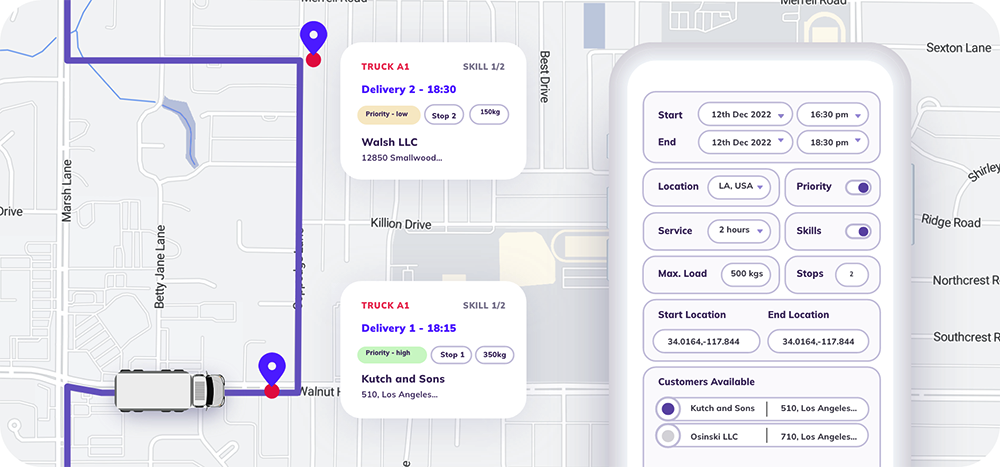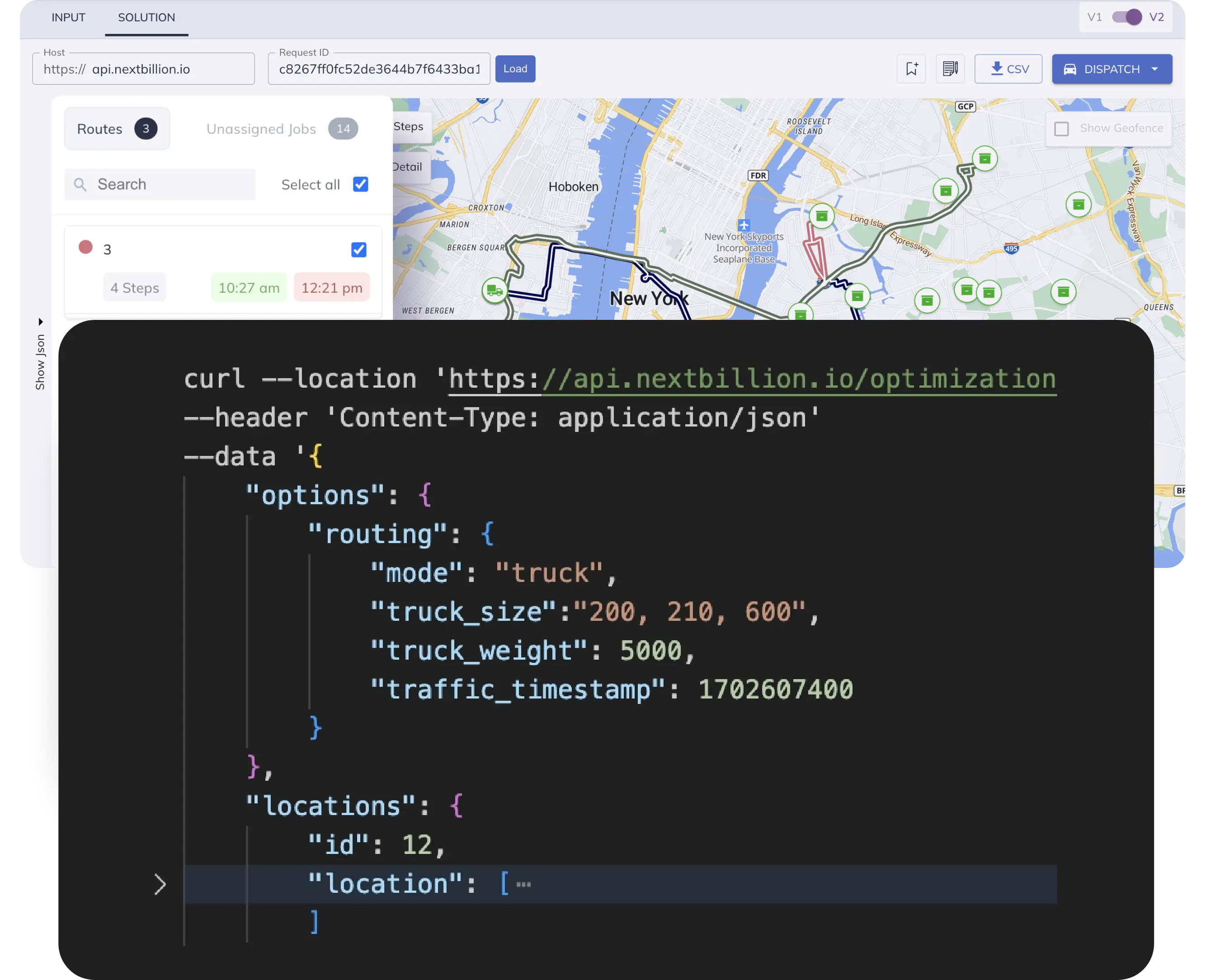Table of Contents
Efficient logistics and transportation are critical drivers of success across a wide range of industries. Whether you’re involved in field service, waste management or fleet management, optimizing your routes can yield significant gains in productivity, cost savings and customer satisfaction.
But do you really understand the fundamental distinctions between route optimization and route planning?
In this blog post, we’ll dive deep into the worlds of route optimization and route planning, shedding light on their differences and highlighting why route optimization often stands as the superior choice for streamlining operations in diverse sectors.
Route Optimization: The Modern Efficiency Boost
Route optimization tools like NextBillion.ai’s Route Optimization API represent a contemporary solution to the age-old challenge of efficient route planning. It takes a step beyond traditional methods by leveraging advanced algorithms to craft custom-tailored, optimal routes that align perfectly with your unique operational needs.
Let’s explore what makes route optimization shine.
Advanced optimization algorithms: Unlike traditional planning methods that rely on basic algorithms or manual inputs, route optimization capitalizes on state-of-the-art algorithms that simultaneously consider multiple variables.
Incorporation of real-time data: Route optimization takes into account real-time data on traffic conditions, delivery time windows, vehicle capacity and more. It’s not just about planning routes; it’s about optimizing them for peak efficiency.
Enhanced cost-effectiveness: By meticulously considering all relevant variables, route optimization helps reduce fuel consumption, cut labor costs and extend vehicle lifespans, resulting in substantial cost savings for your business.
Dynamically adaptable operations: Our world is rife with unforeseen events, from traffic snarls to road closures, and this is where route optimization software shines. It’s agile and capable of swiftly adapting to real-world challenges on the fly, ensuring that your drivers stay productive and deliveries remain punctual.
Route Planning: The Conventional Approach
In contrast to route optimization, route planning software focuses largely on organizing orders in a logical sequence to streamline deliveries. This approach proves effective in simpler operations of relatively small scale.
Below are some points worth noting about route planning.
Logical order for streamlined deliveries: Route planning software excels at arranging deliveries in a logical sequence, ideal for straightforward operations that don’t necessitate nuanced routing.
Emphasis on shortest distance: Typically, route planning prioritizes minimizing travel distance above all else, often overlooking factors like traffic conditions or delivery time windows.
Limited adjustment to dynamic changes: When faced with unforeseen events like road closures, traffic congestion, last-minute order additions or urgent orders, route planning software may not adjust as effectively as route optimization software, potentially leading to inefficiencies.
Route Optimization vs. Route Planning in Field Service
Imagine a company that operates a squad of field service technicians tasked with repairing and maintaining industrial equipment. These technicians adhere to a demanding schedule, addressing service requests from various clients throughout the day. Let’s explore how route optimization can transform their operations.
Route Optimization in Field Service
Efficient technician scheduling: The company employs route optimization software to schedule technician service calls, taking into account variables such as service request location, priority, estimated service duration, technicians’ skill sets, shift timings, etc.
Real-time traffic consideration: As technicians embark on their appointments, the route optimization software continuously monitors traffic conditions. In the face of traffic jams or road closures, it orchestrates automatic reroutes to avert delays.
Optimized route sequencing: The software arranges service calls in an optimal sequence, minimizing travel time between appointments and allowing technicians to dedicate more time to actual repairs. This crucial feature is not limited to route optimization alone; route planning software also excels in optimizing the order of service calls, as stated above. This shared capability enhances the overall efficiency of your field service operations.
Enhanced productivity: With route optimization, technicians can complete more service calls in a day, leading to improved customer satisfaction, enhanced productivity and amplified revenue for the company.
Route Planning in Field Service
Now, let’s explore how traditional route planning might fare in the same field service setting.
Basic scheduling: The company schedules service calls for technicians manually or employs basic software, potentially overlooking variables like real-time traffic conditions or service duration.
Limited adaptability: Once technicians hit the road, their ability to adapt to changing conditions diminishes. Unexpected traffic congestion, for instance, can lead to delays, resulting in service disruptions and potential customer discontent.
Suboptimal routes: In traditional route planning, where routes are often scheduled manually or with basic software that doesn’t consider real-time factors, technicians might inadvertently select longer routes or backtrack between appointments, increasing fuel expenses and reducing overall productivity.
Customer impact: Inefficiencies within route planning could lead to longer customer wait times, potentially harming the company’s reputation and customer retention rates.
Route Optimization vs. Route Planning in Waste Management
Consider a waste management company tasked with collecting garbage and recycling from residential neighborhoods. Route optimization can significantly enhance their daily operations.
Route Optimization for Waste Management
Dynamic collection schedules: The waste management firm employs route optimization software to craft dynamic collection schedules, accounting for variables such as waste volume, pickup point locations, vehicle capacities and live traffic conditions.
Efficient vehicle allocation: The software optimally allocates trucks to specific routes, ensuring full utilization without overloading or inefficiencies.
Real-time updates: In the face of unexpected shifts in waste volume or last-minute requests, the software swiftly adapts routes, minimizing operational disruptions and delays.
Reduced fuel consumption: By optimizing routes, the company reduces vehicle travel distances, idling times and possibly even the number of vehicles required, thereby lowering fuel consumption and curbing carbon emissions.
Route Planning for Waste Management
Now, let’s assess how traditional route planning would impact waste management operations.
Static collection schedules: The company adheres to fixed collection schedules that disregard variations in waste volume and real-world conditions.
Inefficient vehicle allocation: Trucks may be assigned to routes without consideration of their capacity or the optimal order of collection points, resulting in operational inefficiencies.
Limited adaptation: When confronted with unexpected changes, the company must resort to sudden adjustments, which are not the forte of route planning solutions. This could potentially cause delays and service disruptions.
Higher operational costs: Inefficiencies within route planning lead to increased operational costs, including fuel expenses, labor costs and vehicle maintenance.
Choose Route Optimization for Maximum Efficiency
While both route optimization and route planning have their merits, route optimization emerges as the frontrunner in optimizing operations for businesses across various industries.
With advanced algorithms fed by real-time data, route optimization solutions not only plan routes but continuously fine-tune them for peak efficiency, adapting to the ever-changing realities of the world. The result — cost savings, heightened productivity and superior customer satisfaction.
To achieve sustainable success, you’ve got to streamline your operations. Consider adopting route optimization to unlock the full potential of your logistics and transportation efforts, whether in field service, waste management or fleet management.
Schedule a demo with our team to see firsthand how NextBillion.ai’s Route Optimization API can facilitate a smoother and more cost-effective journey toward business success for you.
Ready to get started?
Request a DemoTable of Contents









